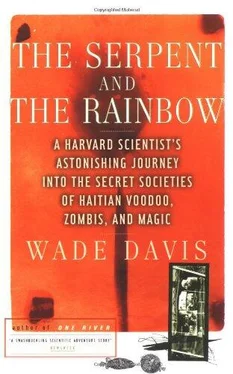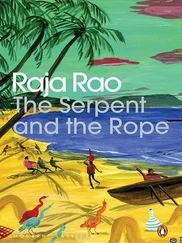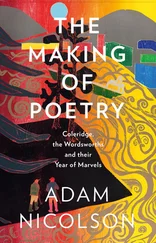Wade Davis - The Serpent and the Rainbow
Здесь есть возможность читать онлайн «Wade Davis - The Serpent and the Rainbow» весь текст электронной книги совершенно бесплатно (целиком полную версию без сокращений). В некоторых случаях можно слушать аудио, скачать через торрент в формате fb2 и присутствует краткое содержание. Год выпуска: 1985, Издательство: Simon & Schuster, Жанр: Старинная литература, на английском языке. Описание произведения, (предисловие) а так же отзывы посетителей доступны на портале библиотеки ЛибКат.
- Название:The Serpent and the Rainbow
- Автор:
- Издательство:Simon & Schuster
- Жанр:
- Год:1985
- ISBN:нет данных
- Рейтинг книги:5 / 5. Голосов: 1
-
Избранное:Добавить в избранное
- Отзывы:
-
Ваша оценка:
- 100
- 1
- 2
- 3
- 4
- 5
The Serpent and the Rainbow: краткое содержание, описание и аннотация
Предлагаем к чтению аннотацию, описание, краткое содержание или предисловие (зависит от того, что написал сам автор книги «The Serpent and the Rainbow»). Если вы не нашли необходимую информацию о книге — напишите в комментариях, мы постараемся отыскать её.
The Serpent and the Rainbow — читать онлайн бесплатно полную книгу (весь текст) целиком
Ниже представлен текст книги, разбитый по страницам. Система сохранения места последней прочитанной страницы, позволяет с удобством читать онлайн бесплатно книгу «The Serpent and the Rainbow», без необходимости каждый раз заново искать на чём Вы остановились. Поставьте закладку, и сможете в любой момент перейти на страницу, на которой закончили чтение.
Интервал:
Закладка:
For an excellent review article on the African ordeal poisons see: Robb, G. L., The ordeal poisons of Madagascar and Africa, Botanical Museum Leaflets—Harvard University 17, no. 10 (1957): 265-316. See also review in Holmstedt, B. (1972).
Zora Hurston’s account of her research in Haiti was published as Tell My Horse , first in 1938 in Philadelphia. It was reprinted in 1981 by Turtle Island, Berkeley. Her autobiography, edited by Robert Hemenway, is Dust Tracks on the Road , and a second edition came out in 1984, published by University of Illinois Press, Urbana, IL.
Typical of the perfunctory dismissals of the possible existence of zombis are: Bourguignon, E., The persistence of folk belief: some notes on cannibalism and zombies in Haiti, Journal of American Folklore 72, no. 283 (1959): 36—47; Laroche, M., The myth of zombi, in Smith, R., ed., Exile and Tradition , 44-61, Longman & Dalhousie University Press, 1976; Mars, L. P., The story of zombi in Haiti, Man 45, no. 22 (1945): 38-40.
The sentiment of these articles was prompted in part by the slew of popular travel books, among them: Craige, J. H., Cannibal Cousins , Minton, Balch & Co., New York, 1934, and by the same author in 1933, Black Bagdad , Minton, Balch & Co., New York. The first in this tradition was St. John, S., Hayti: Or the Black Republic , Frank Cass, London, 1971 [1884]. Others included Seabrook (1929) and Wirkus, F., and T. Dudley, Le Roi blanc de la Gonave , Payot, Paris, 1932.
The Haitian secret societies are mentioned in Métraux, A. (1972), Courlander, H. (1960), Herskovits, M. (1937). The traditional view of the Bizango as a diabolical force is presented in Kerboul, J., Le Vaudou: Magie ou réligion , Editions Robert Laffont, Paris, 1973. For a different view see: Hurbon, L., Sorcellerie et pouvoir en Haiti, Archives des sciences sociales des réligions 48, no. 1 (1979): 43-52. Michel Laguerre’s analysis appeared in 1980 in his article, Bizango: a voodoo secret society in Haiti, in Tefft, S. K., ed., Secrecy , Human Sciences Press, New York. A discussion of informal justice in rural Haiti appears in Montalvo-Despeignes, J., Le Droit Informal Haïtien , Presses Universitaires de France, Paris, 1976.
The reference to the zombi powder that appears in the Old Penal Code [Article 249, cited in Leyburn, J. (1941), p. 164] reads:
Also to be considered as attempted murder, the use that may be made against any person of substances, which, without causing actual death, produce a lethargic coma more or less prolonged. If, after the administering of such substances, the person has been buried, the act shall be considered murder no matter what result follows.
12. DANCING IN THE LION’S JAW
The paradoxical position of the Haitian chef de section is presented by Murray in his 1977 dissertation. For other discussions of the role of the chef de section see: Comhaire, J., The Haitian “Chef de Section,” American Anthropologist 57 (1955): 620-24; Lahav, P., The chef de section: structure and functions of Haiti’s basic administrative institution, in Mintz, S., ed., Working Papers in Haitian Society and Culture 4 (1975): 5-81, Antilles Research Program, Yale University.
13. SWEET AS HONEY, BITTER AS BILE
For an examination of land tenure see once again Murray’s analysis in his dissertation. A summary of his conclusions is presented in: Murray, G. F., Population pressure, land tenure and voodoo: the economics of Haitian peasant ritual, in Beyond the Myths of Culture: Essays in Cultural Materialism , Academic Press, 1980. Issues of land tenure and inheritance relevant to the case of Clairvius Narcisse are discussed in Comhaire, J. (1955), and Underwood, F. W., Land and its manipulation among the Haitian peasantry, in Goodenough, W., ed., Explorations in Cultural Anthropology (1964) 469-82.
For the early philosophical views of François Duvalier see: Denis, L., and F. Duvalier, La civilisation haïtienne: notre mentalité est-elle africaine ou gallo-latine? Revue Anthropologique 10-12 (1936): 353-73; and their later paper published in 1944, L’évolution stadiale du vodou, Bulletin du Bureau d’Ethnologie 2, no. 12: 1-29. Lorimer Denis and Duvalier also published a number of descriptive ethnographic papers based on their observations of various vodoun rituals.
The connection between vodoun and politics in recent Haitian history is examined in: Bastien, R., Vodoun and politics in Haiti, in Religion and Politics in Haiti , Institute for Cross-Cultural Research, Washington, D.C., 1966; Nichols, D., Politics and religion in Haiti, Canadian Journal of Political Science 3, no. 3 (1970): 400-414; Laguerre, M., Voodoo as religious and political ideology, Freeing the Spirit 3, no. 1 (1974): 23-28; Laguerre, M., Voodoo and politics in contemporary Haiti, paper presented at the conference “New Perspectives on Caribbean Studies: Toward the Twenty-first Century,” Research Institute for the Study of Man and the City University of New York, August 28-September 1, 1984.
Two extremely negative interpretations of the Duvalier years are: Diederich, B., and A. Burt, Papa Doc: The Truth about Haiti Today , McGraw-Hill, New York, 1969, and Rotberg, R., Haiti: The Politics of Squalor , Houghton Mifflin Co., Boston, 1971.
Acknowledgments
My research on the zombi phenomenon was undertaken while I was supported by the Social Science and Humanities Research Council of Canada (Doctoral Fellowship). Direct financial support was generously provided by the International Psychiatric Research Foundation, the WennerGren Foundation for Anthropological Research (grant-in-aid 4554) and the National Science Foundation (Doctoral Dissertation Improvement Grant BSN-8411741). My botanical determinations were verified by Professor R. A. Howard of the Arnold Arboretum, Harvard University. Zoological determinations were furnished by the staff of the Museum of Comparative Zoology, Harvard University. Valuable bibliographical material was provided by Professor Bo Holmstedt (Karolinska Institute, Stockholm); Dr. Bruce Halstead (World Life Research Institute); Professor C. Y. Kao (Down State Medical Center, Brooklyn); Professor M. G. Smith (Yale University); and Professor R. E. Schultes (Harvard University). I would especially like to thank Professors Smith and Schultes for their intellectual contributions and encouragement. My understanding of Haitian history is deeply indebted to the excellent work of Dr. Gerald Murray (University of Massachusetts, Boston), Dr. Michel Laguerre (University of California, Berkeley) and Jean Fouchard. The preliminary laboratory work was done by Professor Leon Roizin of Columbia University. For other laboratory work and advice I am indebted to Dr. Laurent Rivier (Université de Lausanne) and Professor James Cottrell and Dr. John Hartung (Down State Medical Center). The Zombi Project was born of the vision of three men: Mr. David Merrick, Professor Heinz Lehman, and the late Dr. Nathan S. Kline.
The work in Haiti was made possible by the cooperation and active support of many individuals. Dr. Lamarque Douyon shared his insights concerning medical aspects of zombification and introduced me to Clairvius Narcisse. Medical records were kindly furnished by the staff of the Albert Schweitzer Hospital. In Port-au-Prince I was kindly received and assisted by Leilas Desquiron, Dr. Max Paul, and his staff at the Institut National Haitien de la Culture et des Arts, Eleanor Snare at the Institut Haitiano-Americain, and Lesly Conde at the National Office of Tourism. In rural Haiti I worked directly with several people who openly shared their knowledge. In particular I would like to thank Jean Baptiste, Jacques Belfort and Madame Jacques, Michel Bonnet, Andrés Cajuste, Andrés Celestin, Robert Erie and his wife, Carmine, Ives François, César Ferdinand, Jean-Jacques Leophin, La Bonté, Miriatel, Jean Price-Mars, Solvis Silvaise, and Marcel Pierre. All of these individuals, some of whom are herein identified by pseudonyms, were directly responsible for the success of the project. Finally I would like to acknowledge Herard Simon and Max Beauvoir. Herard Simon and his wife, Hélène, are serviteurs of the most profound awareness. A great houngan, Herard offered his spiritual and physical protection without which this project would never have been completed. Max Beauvoir was also directly responsible for the success of the project. He and his wife, Elizabeth, and his daughters, Rachel and Estelle, offered me their home and generous hospitality as well as their total support at the most critical moments. Rachel worked with me on every phase of the fieldwork and her enthusiasm, courage, and generosity were unfailing. My debt to her, as to all the people of Haiti who received me so kindly, should be readily apparent in the text of the book.
Читать дальшеИнтервал:
Закладка:
Похожие книги на «The Serpent and the Rainbow»
Представляем Вашему вниманию похожие книги на «The Serpent and the Rainbow» списком для выбора. Мы отобрали схожую по названию и смыслу литературу в надежде предоставить читателям больше вариантов отыскать новые, интересные, ещё непрочитанные произведения.
Обсуждение, отзывы о книге «The Serpent and the Rainbow» и просто собственные мнения читателей. Оставьте ваши комментарии, напишите, что Вы думаете о произведении, его смысле или главных героях. Укажите что конкретно понравилось, а что нет, и почему Вы так считаете.












